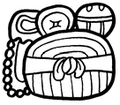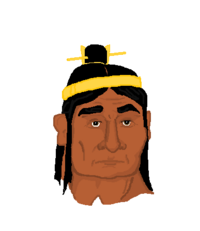Divine Monarchy of the Mutul: Difference between revisions
No edit summary |
|||
| Line 32: | Line 32: | ||
The earliest recorded use of the ''Kuhul Ajaw'' logograph is from the pre-dynastic city of K'o in a tombe that has been dated to the 16th millenium BC. | The earliest recorded use of the ''Kuhul Ajaw'' logograph is from the pre-dynastic city of K'o in a tombe that has been dated to the 16th millenium BC. | ||
== | ==Powers== | ||
To this day the K'uhul Ajaw retain vast powers of the administration of the [[Mutul]], being both the {{wp|Head of state}}, {{wp|Head of government}}, {{wp|Legislature|Head of the legislature}}, {{wp|Judiciary|Head of the Judiciary}}, [[White Path|Religious Head of the Mutul's White Path]] and [[Mutulese Army|Supreme commander of the Mutulese Army]]. For each of these branchs, there exist institutions who can take decision in the absence or with the participation of the Divine Lord, but even the most distant Divine Lords have retained and used of their powers to oversee and check these various assemblies, councils, departments and ministers and their actions to better harmonize the political agenda of the Divine Kingdom. | To this day the K'uhul Ajaw retain vast powers of the administration of the [[Mutul]], being both the {{wp|Head of state}}, {{wp|Head of government}}, {{wp|Legislature|Head of the legislature}}, {{wp|Judiciary|Head of the Judiciary}}, [[White Path|Religious Head of the Mutul's White Path]] and [[Mutulese Army|Supreme commander of the Mutulese Army]]. For each of these branchs, there exist institutions who can take decision in the absence or with the participation of the Divine Lord, but even the most distant Divine Lords have retained and used of their powers to oversee and check these various assemblies, councils, departments and ministers and their actions to better harmonize the political agenda of the Divine Kingdom. | ||
Revision as of 18:20, 15 August 2019
| Divine Lord of The Mutul | |
|---|---|
| K'uhul Ajaw | |
 | |
| Incumbent | |
 | |
| Jasaw Chan K'awiil V since 12 September 1991 | |
| Details | |
| Style | His Holiness Majesty |
| Heir apparent | Janab Pacaal |
| First monarch | Unknown |
| Formation | c. 3000 BC |
| Residence | Chak Yaxnah Ho’kan, K'uhul Muul, K'alak Muul |
The Divine Lord (Mutli: K'uhul Ajaw) is the head of state and chief executive of the Mutul. In traditional Mutulese religious and political theory, the Divine Lord is considered the mortal aspect of Chaak, god of the rain, storms, and lightnings. Divine Lords sharing the same family are classified in historical periods known as Dynasties. The current Dynasty is the 12th recorded, the Ilok'tab Nimja and ascended to the throne during the early 12th century. Since 1991, the Divine Lord is Jasaw Chan K'awiil V, 402th bearer of the title.
The oldest known use of the title of K'uhul Ajaw is five thousand years old, back during the days of the Paol'lunyu Dynasty. Despite many civil wars, struggles, and regime changes, the title never really fell out of use and was transmitted in a nearly un-broken succession. At time however, it was necessary to distinguish the K'uhul Mutul Ajaw from other Divine Lords, such as the K'ul B'ak Ajaw or the K'ul Xepi Ajaw, Divine Lords from other concurrent realms who did not place themselves in the traditional succession line but whom divine natures were nonetheless recognized by the Mutul proper.
Historically, some texts used "Emperor" as a translation for the title. This fell out of use and modern official etiquette guides, published by the Divine Throne for foreign officials and visitors, consider such translation to be improper, advising to prefer the "correct" translation of Divine Lord or to plainly use K'uhul Ajaw instead. In modern Mutli, the word "Emperor" is translated by Kaloomt'e, a title denoting martial qualities and high-rank, like for Imperator, but without any religious connotation.
History
The word "K'uhul Ajaw" is known from several Mutuleses languages albeit with some variations. "Ajaw" is the modernised orthography in the official Ch'iniin Script. Before, foreign scholars or chroniclers more commonly written it as "Ahau" and was translated as meaning either "lord", "ruler", "king" or "leader".
During pre-dynastic times, K'uhul Ajaw indicates a sovereign leader of a polity although it could be applied to persons who in theory recognised the overlordship of another ruler, if their own prestige was great enough. It's only with the ||Paol'lunyu Dynasty]] that the term would come to be reserved to the overlord of Kaminyajunlyu and Ajaw was limited to indicate vassal kings and other members of the aristocracy.
The earliest recorded use of the Kuhul Ajaw logograph is from the pre-dynastic city of K'o in a tombe that has been dated to the 16th millenium BC.
Powers
To this day the K'uhul Ajaw retain vast powers of the administration of the Mutul, being both the Head of state, Head of government, Head of the legislature, Head of the Judiciary, Religious Head of the Mutul's White Path and Supreme commander of the Mutulese Army. For each of these branchs, there exist institutions who can take decision in the absence or with the participation of the Divine Lord, but even the most distant Divine Lords have retained and used of their powers to oversee and check these various assemblies, councils, departments and ministers and their actions to better harmonize the political agenda of the Divine Kingdom.